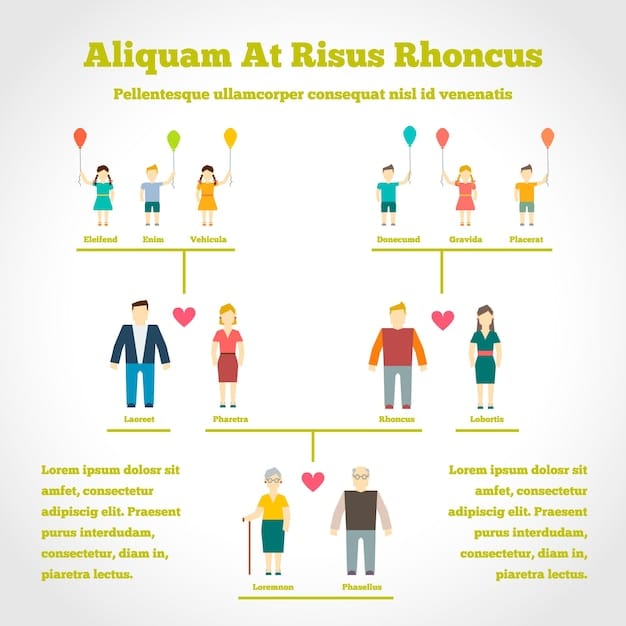Understanding the 10-Year Rule for Social Security Benefits

Understanding the 10-year rule for Social Security benefits is crucial for divorced individuals, as it dictates the eligibility requirements for receiving benefits based on a former spouse’s earnings record, ensuring financial security in retirement.
Understanding the 10-year rule for Social Security benefits can be a game-changer for many divorced individuals. This rule determines whether you’re eligible to receive benefits based on your former spouse’s work record. Let’s dive into the specifics and see how it works.
What is the 10-Year Rule in Social Security Benefits?
The 10-year rule is a critical component of Social Security benefits, particularly for those who have divorced. It dictates the minimum length of marriage required for a divorced individual to claim benefits on their former spouse’s record. Without meeting this requirement, you’re ineligible for these specific benefits.
This rule is designed to protect the integrity of the Social Security system while providing a safety net for divorced individuals who were married long enough to have potentially sacrificed their own career advancement for the sake of the family.

Key Requirements of the 10-Year Rule
To qualify under the 10-year rule, several conditions must be met. Meeting these ensures that the divorced individual has a legitimate claim to their former spouse’s Social Security earnings.
- Length of Marriage: The marriage must have lasted at least 10 years. This is the cornerstone of the rule.
- Divorce Status: You must be divorced. Simply being separated isn’t sufficient.
- Age Requirement: You generally need to be at least 62 years old to start receiving these benefits.
- Unmarried Status: You cannot be currently married. Remarriage typically disqualifies you from claiming benefits on your former spouse’s record unless the subsequent marriage has ended.
These requirements are straightforward but crucial for determining eligibility. It’s essential to verify each condition to understand your potential benefits.
In summary, the 10-year rule is a safeguard, ensuring that divorced individuals who dedicated a significant portion of their lives to a marriage can still receive Social Security benefits based on their former spouse’s contributions.
Who is Eligible for Social Security Benefits Under This Rule?
Eligibility for Social Security benefits under the 10-year rule extends specifically to divorced individuals. However, not all divorced individuals automatically qualify. Several criteria must be satisfied to determine eligibility and access these benefits.
Understanding these requirements ensures that those who are eligible can leverage this provision to enhance their retirement income.
Specific Eligibility Criteria
The Social Security Administration (SSA) has defined specific criteria to determine who can claim benefits under the 10-year rule. Here’s a detailed look:
- Divorced: You must be legally divorced from your former spouse.
- Minimum Marriage Duration: The marriage must have lasted for a minimum of 10 years.
- Age Requirement: Generally, you must be at least 62 years old. This is the standard age to start receiving retirement benefits.
- Unmarried: You must not be currently married. Remarriage typically disqualifies you from receiving benefits on your former spouse’s record, unless your subsequent marriage ends.
- Former Spouse’s Eligibility: Your former spouse must be entitled to Social Security benefits, or they must be eligible even if they aren’t currently receiving them.
These criteria ensure that only those who meet the specific conditions can claim benefits based on their former spouse’s record.
Meeting these criteria is crucial for qualifying for Social Security benefits under the 10-year rule. It is important to gather all necessary documentation and verify eligibility with the SSA to avoid any complications.
How Does the 10-Year Rule Affect Benefit Amounts?
The 10-year rule not only determines eligibility but also influences the amount of Social Security benefits a divorced individual can receive. The calculation involves considering factors like the former spouse’s earnings and the claiming age. Understanding these aspects can help individuals anticipate their potential benefit amount.
The calculation of benefits under the 10-year rule can be complex, but an understanding of the basic principles can help you estimate what you might receive.
Calculating Benefit Amounts
The amount of benefits a divorced individual can receive under the 10-year rule is based on several factors. These are generally the same factors used to calculate any Social Security retirement benefit.
- Former Spouse’s Earnings: The primary basis for calculating the benefit is the former spouse’s earnings record.
- Benefit Amount: If you claim benefits at your full retirement age, you can receive up to 50% of your former spouse’s primary insurance amount (PIA). The PIA is the benefit your former spouse is entitled to at their full retirement age.
- Early Retirement: If you claim benefits before your full retirement age, the benefit amount is reduced. For instance, claiming at age 62 results in a lower percentage of the former spouse’s PIA.
- Own Work Record: If you are also entitled to Social Security benefits based on your own work record, you will receive the higher of the two benefits – either from your own record or up to 50% of your former spouse’s PIA.

In conclusion, the 10-year rule allows divorced individuals to claim benefits based on their former spouse’s earnings. The amount they receive depends on their age at the time of claiming and their former spouse’s primary insurance amount. Understanding these factors ensures that eligible individuals can plan for their retirement income effectively.
What Happens If My Former Spouse Has Remarried?
The remarriage status of your former spouse can have implications on your ability to claim Social Security benefits under the 10-year rule. The rules regarding remarriage are specific and designed to prevent misuse of the system. Let’s explore how these rules can affect you.
The key is to understand how your former spouse’s marital status interacts with your eligibility to claim benefits as a divorced individual.
Rules Regarding Remarriage
The main factor influencing your benefit eligibility involves whether you have remarried. Here’s a breakdown of the rules:
- Your Remarriage: If you remarry before the age of 60, you generally lose eligibility to claim benefits on your former spouse’s record. However, if you remarry after age 60, this may not affect your eligibility.
- Former Spouse’s Remarriage: The good news is that if your former spouse remarries, it does not affect your ability to collect benefits on their record, provided you meet all other eligibility requirements.
While your remarriage before a certain age can disqualify you, your former spouse’s remarriage does not affect your benefits. These rules aim to balance providing support to divorced individuals while maintaining the integrity of the Social Security system.
Understanding these rules ensures that divorced individuals can make informed decisions about remarriage and its potential impact on their Social Security benefits. It emphasizes the importance of knowing the specific age thresholds and how they affect eligibility.
How to Apply for Social Security Benefits Under the 10-Year Rule?
Applying for Social Security benefits under the 10-year rule involves specific steps and documentation to ensure a smooth process. Knowing what to expect and how to prepare can save time and prevent complications. Here are guidelines for applying.
The application process requires attention to detail, proper documentation, and an understanding of the specific forms and steps involved.
Steps to Apply
The process for applying for Social Security benefits under the 10-year rule involves several key steps. Following these steps can help ensure a successful application.
- Gather Necessary Documents: Collect important documents such as your birth certificate, divorce decree, and any records of your former spouse’s Social Security number.
- Complete the Application: You can apply online through the Social Security Administration’s website or visit a local Social Security office.
- Provide Proof of Marriage: Ensure your marriage lasted at least 10 years by providing the necessary documentation.
- Verify Eligibility: Double-check that you meet all eligibility requirements, including age and current marital status.
- Submit the Application: Once you’ve completed the application and gathered all necessary documents, submit it to the SSA.
By following these steps and preparing the necessary documents, applicants can navigate the process with greater ease and confidence.
In summary, applying for Social Security benefits under the 10-year rule requires gathering the correct documents, completing the application form, and submitting them to the SSA. Being prepared and verifying your eligibility can help ensure a smooth and successful application process.
Common Misconceptions About the 10-Year Rule
Several misconceptions surround the 10-year rule for Social Security benefits, leading to confusion and misinformation. Clearing up these misunderstandings ensures individuals have accurate knowledge to make informed decisions.
Addressing these common myths can help individuals better understand their rights and options regarding Social Security benefits.
Debunking the Myths
Let’s address some prevalent misconceptions about the 10-year rule:
- Myth 1: You must contact your former spouse to apply.
Fact: You do not need to contact your former spouse to claim benefits. The SSA will process your application based on the information you provide. - Myth 2: Your benefits reduce your former spouse’s benefits.
Fact: Claiming benefits on your former spouse’s record does not reduce the benefits they or their current spouse receive. - Myth 3: The 10-year rule applies only to women.
Fact: Both men and women are eligible to claim benefits on their former spouse’s record if they meet the eligibility requirements.
Understanding and dispelling these myths is crucial for making informed decisions about Social Security benefits. Armed with accurate information, individuals can confidently navigate the system and secure the benefits they are entitled to.
To sum up, the 10-year rule is often misunderstood. Clearing up these common misconceptions can empower individuals to access the benefits they are eligible for, ensuring a more financially secure retirement.
| Key Point | Brief Description |
|---|---|
| ⏰ 10-Year Marriage | Marriage must last at least 10 years to qualify. |
| 🎂 Age 62+ | You generally need to be at least 62 years old. |
| 💍 Unmarried Status | Being currently unmarried is a key requirement. |
| 💰 Benefit Amount | Up to 50% of former spouse’s primary insurance amount. |
Frequently Asked Questions
▼
The primary requirement is that the marriage lasted at least 10 years. This is the fundamental condition that allows a divorced individual to claim benefits on their former spouse’s record.
▼
No, your former spouse’s remarriage does not affect your eligibility to claim benefits on their record, as long as you meet all other requirements such as age and marital status.
▼
Generally, if you remarry before age 60, you lose eligibility to claim benefits on your former spouse’s record. Remarrying after age 60 might not affect your benefit eligibility.
▼
The benefit amount is based on your former spouse’s earnings record. If you claim benefits at your full retirement age, you can receive up to 50% of their primary insurance amount.
▼
No, you do not need to contact your former spouse to apply for benefits. The Social Security Administration will process your application based on the information you provide.
Conclusion
In summary, understanding the 10-year rule for Social Security benefits is crucial for divorced individuals seeking to secure their financial future. By knowing the eligibility requirements, application process, and potential benefit amounts, you can make informed decisions and confidently navigate the Social Security system.





